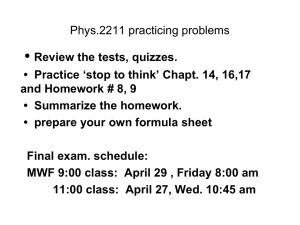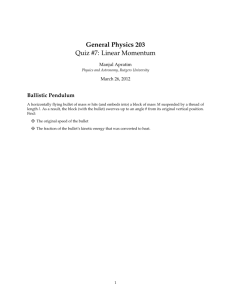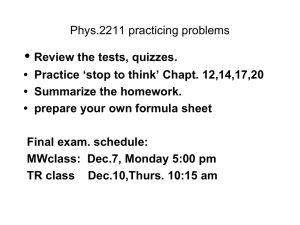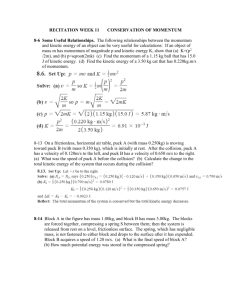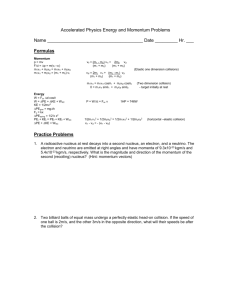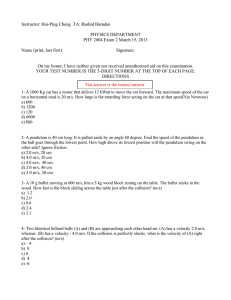S Mechanical Energy Changes in Perfectly Inelastic Collisions Carl E. Mungan,
advertisement
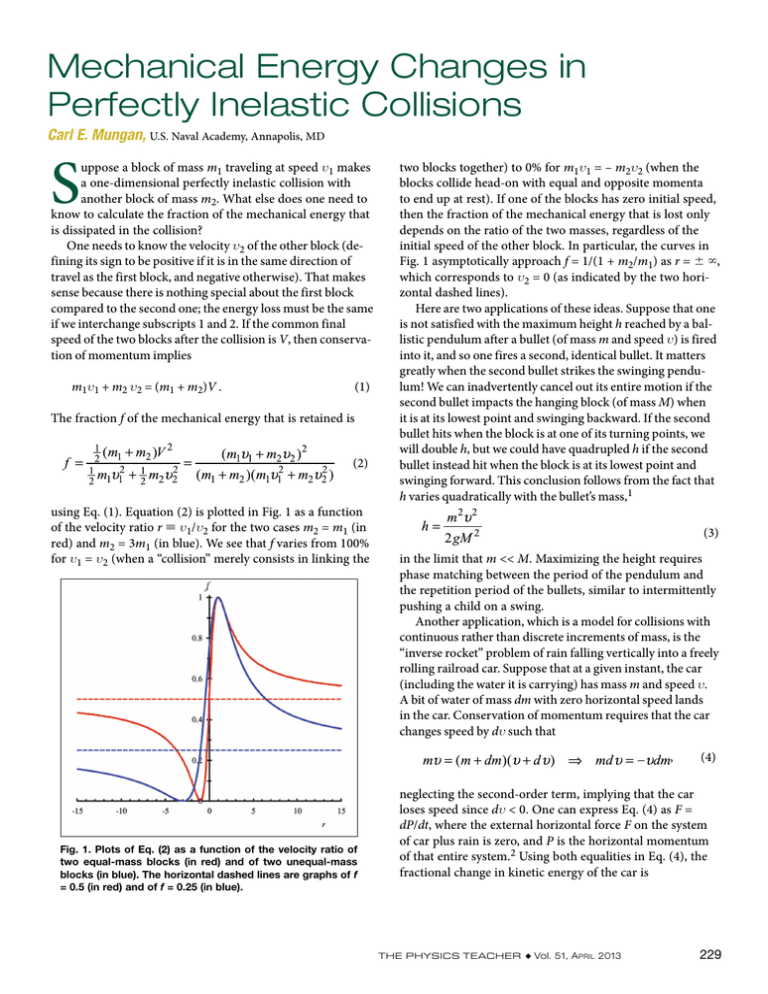
Mechanical Energy Changes in Perfectly Inelastic Collisions Carl E. Mungan, U.S. Naval Academy, Annapolis, MD S uppose a block of mass m1 traveling at speed u1 makes a one-dimensional perfectly inelastic collision with another block of mass m2. What else does one need to know to calculate the fraction of the mechanical energy that is dissipated in the collision? One needs to know the velocity u2 of the other block (defining its sign to be positive if it is in the same direction of travel as the first block, and negative otherwise). That makes sense because there is nothing special about the first block compared to the second one; the energy loss must be the same if we interchange subscripts 1 and 2. If the common final speed of the two blocks after the collision is V, then conservation of momentum implies m1u1 + m2 u2 = (m1 + m2)V . (1) The fraction f of the mechanical energy that is retained is (2) using Eq. (1). Equation (2) is plotted in Fig. 1 as a function of the velocity ratio r u1/u2 for the two cases m2 = m1 (in red) and m2 = 3m1 (in blue). We see that f varies from 100% for u1 = u2 (when a “collision” merely consists in linking the two blocks together) to 0% for m1u1 = – m2u2 (when the blocks collide head-on with equal and opposite momenta to end up at rest). If one of the blocks has zero initial speed, then the fraction of the mechanical energy that is lost only depends on the ratio of the two masses, regardless of the initial speed of the other block. In particular, the curves in Fig. 1 asymptotically approach f = 1/(1 + m2/m1) as r = , which corresponds to u2 = 0 (as indicated by the two horizontal dashed lines). Here are two applications of these ideas. Suppose that one is not satisfied with the maximum height h reached by a ballistic pendulum after a bullet (of mass m and speed u) is fired into it, and so one fires a second, identical bullet. It matters greatly when the second bullet strikes the swinging pendulum! We can inadvertently cancel out its entire motion if the second bullet impacts the hanging block (of mass M) when it is at its lowest point and swinging backward. If the second bullet hits when the block is at one of its turning points, we will double h, but we could have quadrupled h if the second bullet instead hit when the block is at its lowest point and swinging forward. This conclusion follows from the fact that h varies quadratically with the bullet’s mass,1 (3) in the limit that m << M. Maximizing the height requires phase matching between the period of the pendulum and the repetition period of the bullets, similar to intermittently pushing a child on a swing. Another application, which is a model for collisions with continuous rather than discrete increments of mass, is the “inverse rocket” problem of rain falling vertically into a freely rolling railroad car. Suppose that at a given instant, the car (including the water it is carrying) has mass m and speed u. A bit of water of mass dm with zero horizontal speed lands in the car. Conservation of momentum requires that the car changes speed by du such that , Fig. 1. Plots of Eq. (2) as a function of the velocity ratio of two equal-mass blocks (in red) and of two unequal-mass blocks (in blue). The horizontal dashed lines are graphs of f = 0.5 (in red) and of f = 0.25 (in blue). (4) neglecting the second-order term, implying that the car loses speed since du < 0. One can express Eq. (4) as F = dP/dt, where the external horizontal force F on the system of car plus rain is zero, and P is the horizontal momentum of that entire system.2 Using both equalities in Eq. (4), the fractional change in kinetic energy of the car is The Physics Teacher ◆ Vol. 51, April 2013 229 Look What’s NEW in The Physics Store! Fizz: Nothing is as it seems by Zvi Schreiber A YOUNG WOMAN’S QUEST TO UNRAVEL THE UNIVERSE The future. In response to environmental degradation, the Eco-community sect eschews science and technology, returning to an austere agricultural life of nature-worship. But one young member, Fizz, struggles to reconcile these doctrines with her own burning curiosity. Risking life and social standing, Fizz embarks on a quest that brings her face-to-face with the often-eccentric giants of physics, from Aristotle and Galileo to Einstein and Hawking. One encounter at a time, Fizz pieces together the intricate workings of our universe, while struggling with the resulting intellectual, moral, and personal challenges. All proceeds will be used to support AAPT’s Student Fund, which primarily goes to the Outstanding Student program! Although the car gains mass, it loses kinetic energy because of its drop in speed. Integrating both sides of Eq. (5), if rain falls into it at constant rate R (in kg/s), then the car’s kinetic energy decreases in time t according to K(t) = K0 /(1 + Rt/m0) , Order yours now at www.aapt.org/store 230 The Physics Teacher ◆ Vol. 51, April 2013 (6) where is the initial kinetic energy. Defining a time constant t = m0 /R, the kinetic energy falls to a half in one time constant, to a third in two time constants, to a quarter in three time constants, and so on. Kinetic energy is not lost at a constant rate, even though water is falling into it at a constant rate; instead, the car loses more mechanical energy per second when it is moving fast than when it is moving slow. References 1. J. W. Zwart, “A safe and inexpensive ballistic pendulum,” Phys. Teach. 25, 447–448 (Oct. 1987). 2. In a perfectly inelastic collision, dP/dt only reduces to d(mu)/ dt if the collected mass elements have zero initial momentum, which is equivalent to u = –u in J. Mallinckrodt, “F does not equal d(mu)/dt ,” letter to the editor, Phys. Teach. 48, 360 (Sept. 2010). For example, F = d(mu)/dt holds for a raindrop falling through stationary mist (because the mist has zero initial momentum) as in C. E. Mungan, “More about the falling raindrop,” Am. J. Phys. 78, 1421 (Dec. 2010). In contrast, it does not hold for a horizontally moving funnel adding sand into a cart (because the sand is initially moving with the cart’s velocity) as in W. Kunkel and R. Harrington, “Modeling the motion of an increasing mass system,” Phys. Teach. 48, 243–245 (April 2010). Members: $7.50 Non-Members: $9.50 (5) Carl Mungan is an associate professor of physics at the United States Naval Academy. U.S. Naval Academy, Physics Department, Annapolis, MD 21401; mungan@usna.edu
